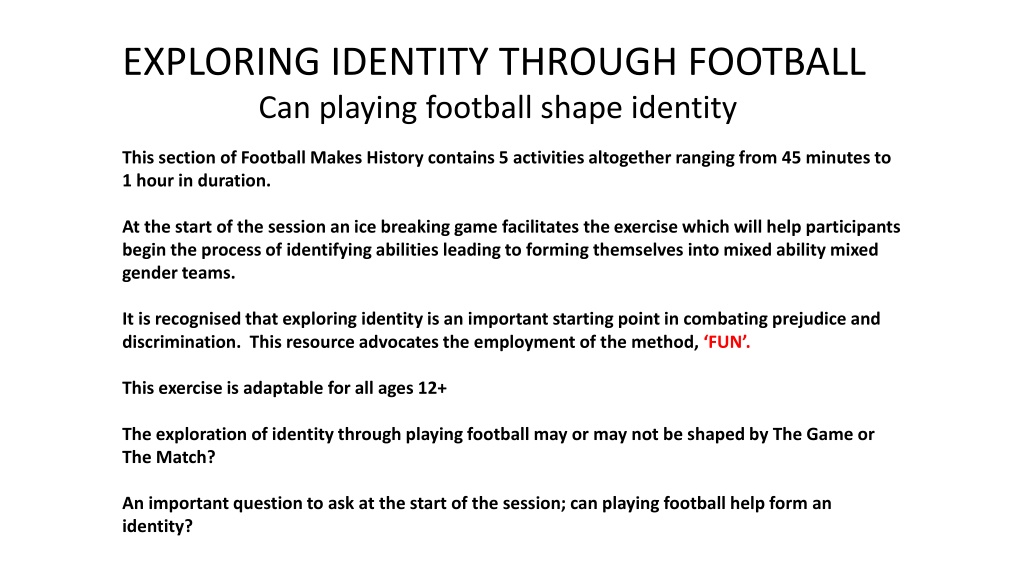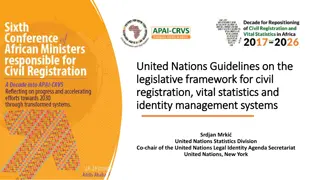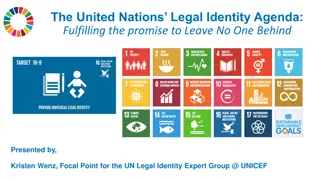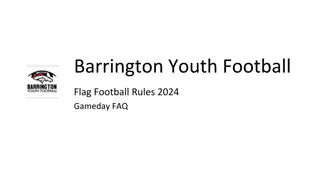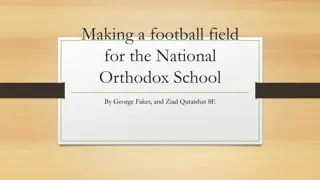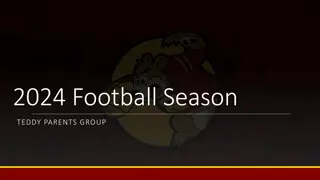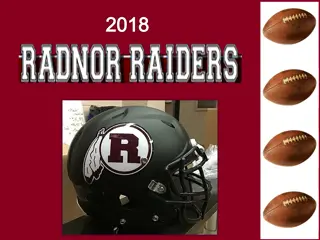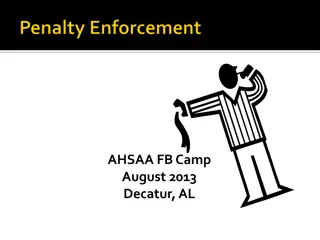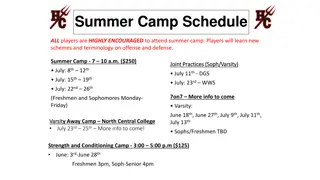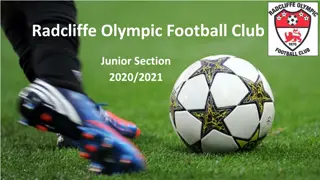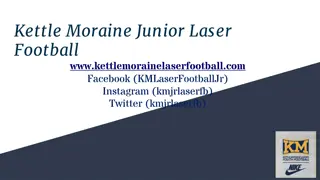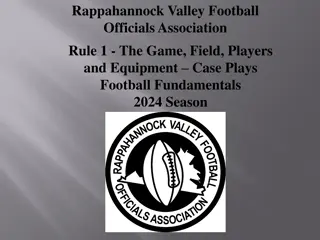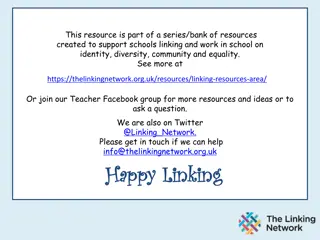Exploring Identity Through Football Activities
This resource explores how playing football can shape identity and combat prejudice through 5 activities focusing on team formation, reflection, and discussion. Participants engage in ice-breaking games, examine visible and sensory identities, and discuss similarities and differences with others. The aim is to understand the complexity and fluidity of identity. The methodology includes various interactive games to facilitate the sessions.
Download Presentation

Please find below an Image/Link to download the presentation.
The content on the website is provided AS IS for your information and personal use only. It may not be sold, licensed, or shared on other websites without obtaining consent from the author. Download presentation by click this link. If you encounter any issues during the download, it is possible that the publisher has removed the file from their server.
E N D
Presentation Transcript
EXPLORING IDENTITY THROUGH FOOTBALL Can playing football shape identity This section of Football Makes History contains 5 activities altogether ranging from 45 minutes to 1 hour in duration. At the start of the session an ice breaking game facilitates the exercise which will help participants begin the process of identifying abilities leading to forming themselves into mixed ability mixed gender teams. It is recognised that exploring identity is an important starting point in combating prejudice and discrimination. This resource advocates the employment of the method, FUN . This exercise is adaptable for all ages 12+ The exploration of identity through playing football may or may not be shaped by The Game or The Match? An important question to ask at the start of the session; can playing football help form an identity?
DEFINITION A GAME an activity that one (children) engages in for amusement or fun A MATCH each other in a sport. a contest in which adults or teams compete against Does the environment add to playing or supporting a game of football with or without prejudice?
Sometimes, people can feel that they have nothing in common with someone that is playing or supporting the other side. These activities give young people the opportunity to reflect upon their game / match, explore the similarities and differences that they share with other players and supporters. All the activities provide starting points for young participants to discuss who they think they are? The issues that will be raised after the activities will be the starting point of the discussion. AIM TO UNDERSTAND HOW PLAYING FOOTBALL CAN SHAPE OUR IDENTITY: To open-up discussions amongst participants. To illustrate that identity is complex and individual To demonstrate how not all aspects of identity are visible To highlight that identity is not fixed, but can change over time
OBJECTIVES how to be aware of a visible identity how to be aware of another sensory identity. how to identify team-mates. how to identify my team players. how to identify game play.
METHODOLOGY MAGIC REGTANGLE; featuring four grids that will facilitate all games in a round robin, format. NO MAN S LAND (Ice Breaker) TRUST CHAOS INCLUSION (Connection) IS IT A GAME OR IS IT A MATCH
NOTE IT IS IMPORTANT TO CONVEY TO THE PARTICIPANTS THAT THERE ARE NO RIGHT OR WRONG ANSWERS. IN ORDER TO EXPLORE IDENTITY IN THE GROUP THEIR NEEDS TO BE AN UNDERSTANDING ESTABLISHED AT THE BEGINNING OF THE ACTIVITIES THAT ALL PARTICIPANTS CAN TALK FREELY WITHOUT PREJUDICE.
ICE BREAKER NO MAN S LAND A A A A A A AIM Can the Families get their football safely through the cross fire of the Armies. F NO MAN S LAND F F F F F F F A A A A A A
EVALUATION Ask the players which senses did they use in order to avoid the cross- fire? Ask the Families how they identified the easiest route through no man s land? Ask the Armies how did their identify / cope with the scenario? Explain that some elements of our identity are visible but that a lot are invisible. Using the flipchart / white board for inspiration, ask the players to write one word that describes their identity in no mans land. With the aid of the players the facilitator can then add the words to the following chart:
FLIP CHART SENSES VISIBLE STEREOTYPES INVISIBLE Listening: accents, tone, inflexions. Hair colour / style Eye colour Skin colour Height Weight Attire / Choice of clothing Age Religion Gender Abilities / disabilities Job / school we attend Personality Likes and dislikes Hopes and fears Strengths and weaknesses Family Friendships Where we live Where our parents are from Hobbies Favourite school subject Life experiences Nationality Ethnicity or family background Morals Interests Languages Habits Communities / groups Smell: sweet, harsh, pleasant. Touch: strong, soft, rough.
TIPS TO EDUCATOR: Size of play area / grids; adaptable to number of participants / ability / indoor / outdoor Mindful of scenario. Adapt the ice breaker to sharks and crocodiles, cops and robbers, etc Keep it fun brief introduction Every player actively involved Switch roles of participants after two constants
BLINDFOLDED PARTICIPANTS TRUST BF BF BF BF BF BF AIM The first blinded folded participant that reaches their partner on the other side of the grid before anyone else TRUST P P P P P P PARTNERS
EVALUATION Ask the players did they trust their partner? Ask the players how and why did they trust their partner? How does the game of trust challenge identity? Reiterate that some elements of our identity are visible, however, a lot are invisible. Does our identity change when we are denied a sense? Using the flipchart / white board for inspiration, ask the players to write one word that described their identity in the game of trust? With the aid of the players the facilitator can then add the words to the following chart:.
FLIP CHART SENSES VISIBLE STEREOTYPES INVISIBLE Listening: accents, tone, inflexions. Hair colour / style Eye colour Skin colour Height Weight Attire / Choice of clothing Age Religion Gender Abilities / disabilities Job / school we attend Personality Likes and dislikes Hopes and fears Strengths and weaknesses Family Friendships Where we live Where our parents are from Hobbies Favourite school subject Life experiences Nationality Ethnicity or family background Morals Interests Languages Habits Communities / groups Smell: sweet, harsh, pleasant. Touch: strong, soft, rough.
TIPS TO EDUCATOR: Size of play area / grids; adaptable to number of participants / ability / indoor / outdoor Keep it fun brief introduction Every player actively involved Switch roles of participants after two constants
CHAOS AIM Score the most goals in a short period of time CHAOS Everyone gets a touch of the ball
EVALUATION Ask the players did they identify their team-mates - how? Ask the players did they accommodate their team-mates identity? Ask the players to consider to what extent did fair play feature in the Chaos game? Reiterate that some elements of our identity are visible but that a lot are invisible? Does our identity change when we are in chaos? Using the flipchart / white board for inspiration, ask the players to write one word that described their identity in the game of chaos. With the aid of the players the facilitator can then add the words to the following chart:
FLIP CHART SENSES VISIBLE STEREOTYPES INVISIBLE Listening: accents, tone, inflexions. Hair colour / style Eye colour Skin colour Height Weight Attire / Choice of clothing Age Religion Gender Abilities / disabilities Job / school we attend Personality Likes and dislikes Hopes and fears Strengths and weaknesses Family Friendships Where we live Where our parents are from Hobbies Favourite school subject Life experiences Nationality Ethnicity or family background Morals Interests Languages Habits Communities / groups Smell: sweet, harsh, pleasant. Touch: strong, soft, rough.
TIPS TO EDUCATOR: Size of play area / grids; adaptable to number of participants / ability / indoor / outdoor Keep it fun brief introduction Every player actively involved In order to make sure everyone is actively involved you can add inclusion conditions.
INCLUSION AIM To explore how many different ways to score a goal SIT OF THE BALL EVERYONE TO SCORE INCLUSION s PLACE YOUR KNEE ON THE BALL HIT THE CONE
EVALUATION Ask the players why does inclusivity decrease win at all costs? Ask the players did they provide support for other players? Does our identity change when we are inclusive? Using the flipchart / white board for inspiration, ask the players to write one word that described their identity in the game of trust?. With the aid of the players the facilitator can then add the words to the following chart:.
FLIP CHART SENSES VISIBLE STEREOTYPES INVISIBLE Listening: accents, tone, inflexions. Hair colour / style Eye colour Skin colour Height Weight Attire / Choice of clothing Age Religion Gender Abilities / disabilities Job / school we attend Personality Likes and dislikes Hopes and fears Strengths and weaknesses Family Friendships Where we live Where our parents are from Hobbies Favourite school subject Life experiences Nationality Ethnicity or family background Morals Interests Languages Habits Communities / groups Smell: sweet, harsh, pleasant. Touch: strong, soft, rough.
TIPS TO EDUCATOR: Size of play area / grids; adaptable to number of participants / ability / indoor / outdoor Keep it fun brief introduction Every player actively involved Switch roles of participants after two constants
THE GAME OR THE MATCH AIM To think about competition and its impact on individual s identity To consider how prejudice through play escalates and forms a hostile identity To consider your role in preventing the escalation of hate through play To consider what can be done to present hostile attitudes / win at all cost To consider at what point does the game turn into a match
EVALUATION Ask the players why does inclusivity decrease win at all costs? Ask the players did they provide support for other players? Does our identity change when we are participating in game play or match play? Using the flipchart / white board for inspiration, ask the players to write one word that described their identity in the game of trust?. With the aid of the players the facilitator can then add the words to the following chart:.
FLIP CHART SENSES VISIBLE STEREOTYPES INVISIBLE Listening: accents, tone, inflexions. Hair colour / style Eye colour Skin colour Height Weight Attire / Choice of clothing Age Religion Gender Abilities / disabilities Job / school we attend Personality Likes and dislikes Hopes and fears Strengths and weaknesses Family Friendships Where we live Where our parents are from Hobbies Favourite school subject Life experiences Nationality Ethnicity or family background Morals Interests Languages Habits Communities / groups Smell: sweet, harsh, pleasant. Touch: strong, soft, rough.
TIPS TO EDUCATOR: Consider size of play area Keep it fun brief introduction Every player actively involved
